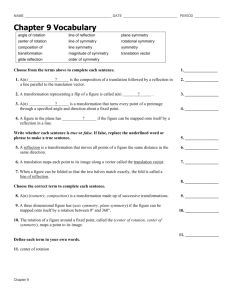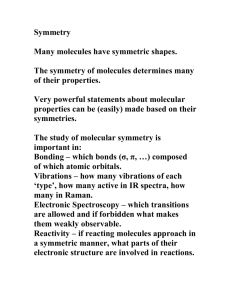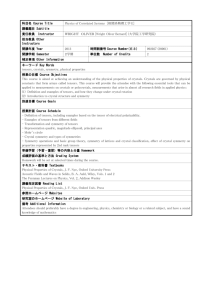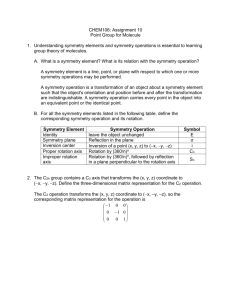Symmetry Operations, Bravais - University of South Alabama
advertisement
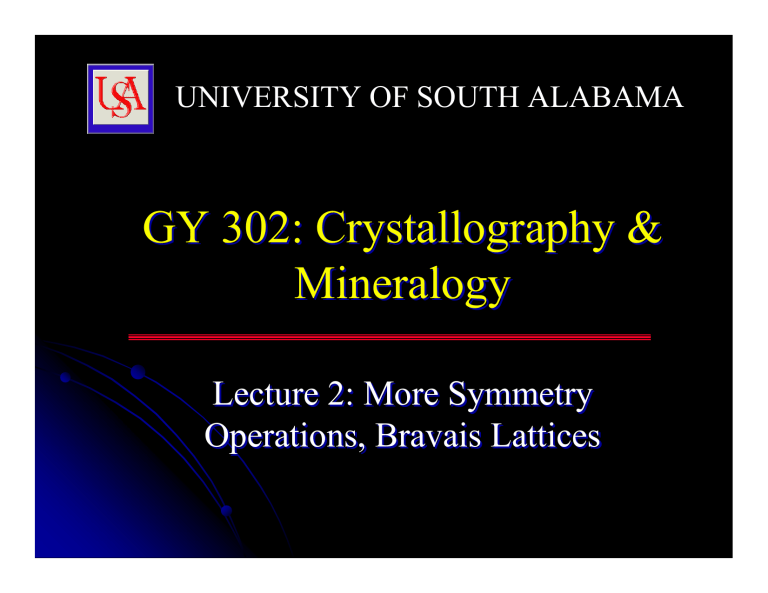
UNIVERSITY OF SOUTH ALABAMA
GY 302: Crystallography &
Mineralogy
Lecture 2: More Symmetry
Operations, Bravais Lattices
Last Time
A long winded introduction
Introduction to crystallography
Symmetry
Crystal Systems
The 6 (or 7) Crystal Systems.
Crystal System
Axes
Angles between axes
Mineral examples
1
Cubic
a=b=c
" =$ =( =90°
Halite, Galena, Pyrite
2
Tetragonal
a=b≠c
" =$ =( =90°
Zircon
3a
Hexagonal
a1= a2=a3≠ c
" =$ =120° , ( =90°
Apatite
3b
Trigonal
a= a1=b≠ c
" =$ =120° , ( =90°
Quartz, Calcite
4
Orthorhombic
a≠b≠c
" =$ =( =90°
Aragonite, Staurolite
5
Monoclinic
a≠b≠c
" =$ =90° , ( ≠ 90°
Gypsum, Orthoclase
6
Triclinic
a≠b≠c
" ≠ $ ≠ ( ≠ 90°
Plagioclase
Crystal Systems
In order to fully understand how crystals are “put together”, We
need to reconsider symmetry.
In the last lab, we examined 3 symmetry operations:
1) Reflection (mirror planes)
Crystal Systems
In order to fully understand how crystals are “put together”, We
need to reconsider symmetry.
In the last lab, we examined 3 symmetry operations:
1) Reflection (mirror planes)
2) Rotation (2, 3, 4, 6 fold axes)
Crystal Systems
There are two other operations that we did not have a chance to
discuss at the start of lab 1 (e.g., rotoinversion)
1) Reflection (mirror planes)
2) Rotation (2, 3, 4, 6 fold axes)
3) Inversion
Center of
Inversion
Crystal Systems
1) Reflection (mirror planes)
2) Rotation (2, 3, 4, 6 fold axes)
3) Inversion
4) Translation
5) Screw Rotation
6) Glide Rotation
7) Rotoinversion
Basic symmetry
operations
Compound symmetry
operations
Today’s Agenda
Rotoinversion
Translational Symmetry
3. Bravais Lattices
1.
2.
Symmetry in Crystals
Rotation axes:
2-fold Rotation Axis - If an object appears
identical after a rotation of 180o, that is twice in a
360o rotation, then it is said to have a 2-fold
rotation axis (360/180 = 2).
Note that in these examples the axes we are
referring to are imaginary lines that extend toward
you perpendicular to the page or blackboard. A
filled oval shape represents the point where the 2fold rotation axis intersects the page.
http://www.cartage.org.lb
Symmetry in Crystals
Rotation axes:
3-fold Rotation Axis - Objects that repeat
themselves upon rotation of 120o are said to have
a 3-fold axis of rotational symmetry (360/120 =3),
and they will repeat 3 times in a 360o rotation. A
filled triangle is used to symbolize the location of
3-fold rotation axis.
http://www.cartage.org.lb
Symmetry in Crystals
Rotation axes:
4-fold Rotation Axis - If an object repeats itself
after 90o of rotation, it will repeat 4 times in a
360o rotation, as illustrated previously. A filled
square is used to symbolize the location of 4-fold
axis of rotational symmetry.
http://www.cartage.org.lb
Symmetry in Crystals
Rotation axes:
6-fold Rotation Axis -If rotation of 60o about an
axis causes the object to repeat itself, then it has 6fold axis of rotational symmetry
(360/60=6). A filled hexagon is used as the
symbol for a 6-fold rotation axis.
http://www.cartage.org.lb
Symmetry in Crystals
Rotation axes:
http://www.cartage.org.lb
Although objects themselves may appear to have 5-fold, 7-fold, 8-fold, or 12-fold
rotation axes, these are not possible in crystals. The reason is that the external shape of
a crystal is based on a geometric arrangement of atoms and they must be able to
completely fill in space in order to exist in nature (Think unit cells or floor tiles).
Symmetry in Crystals
Rotoinversion: A combination of rotation with a center of
inversion.
http://www.cartage.org.lb
Symmetry in Crystals
look down this axis
Symmetry in Crystals
look down this axis
2 fold rotation
Symmetry in Crystals
look down this axis
2 fold rotation
invert
Symmetry in Crystals
Rotoinversion: A combination of rotation with a center of
inversion.
2-fold Rotoinversion - The operation of 2-fold
rotoinversion involves first rotating the object
by 180 degrees then inverting it through an
inversion center.
This operation is equivalent to having a mirror
plane perpendicular to the 2-fold rotoinversion
axis.
http://www.cartage.org.lb
Symmetry in Crystals
Rotoinversion: A combination of rotation with a center of
inversion.
3-fold Rotoinversion - This involves rotating
the object by 120o (360/3 = 120), and inverting
through a center. A cube is good example of
an object that possesses 3-fold rotoinversion
axes.
http://www.cartage.org.lb
Symmetry in Crystals
Rotoinversion: A combination of rotation with a center of
inversion.
4-fold Rotoinversion - This involves rotation of the object
by 90o then inverting through a center.
Note that an object possessing a 4- fold rotoinversion axis
will have two faces on top and two identical faces upside
down on the bottom, if the axis is held in the vertical
position.
http://www.cartage.org.lb
Symmetry in Crystals
Rotoinversion: A combination of rotation with a center of
inversion.
6-fold Rotoinversion - involves rotating the object by 60o
and inverting through a center. Note that this operation is
identical to having the combination of a 2-fold rotation
axis perpendicular to a mirror plane.
http://www.cartage.org.lb
Symmetry in Crystals
Translation: Repetition of points by lateral displacement.
Consider 1 dimensional translations:
Symmetry in Crystals
Translation: Repetition of points by lateral displacement.
Consider 1 dimensional translations:
Symmetry in Crystals
Translation: Repetition of points by lateral displacement.
Consider 1 dimensional translations:
a
Symmetry in Crystals
Translation: Repetition of points by lateral displacement.
Consider 1 dimensional translations:
a
a
Symmetry in Crystals
Translation: Repetition of points by lateral displacement.
Consider 1 dimensional translations:
a
a
a
Symmetry in Crystals
Translation: Repetition of points by lateral displacement.
Consider 2 dimensional translations:
a
a
a
b
Symmetry in Crystals
Translation: Repetition of points by lateral displacement.
Consider 2 dimensional translations:
a
a
a
b
b
a
Symmetry in Crystals
Translation: Repetition of points by lateral displacement.
Consider 2 dimensional translations:
a
a
a
b
a
b
a
b
a
Symmetry in Crystals
Translation: Repetition of points by lateral displacement.
Consider 2 dimensional translations:
a
a
a
b
a
b
a
b
a
b
Symmetry in Crystals
Translation: Repetition of points by lateral displacement.
Consider 2 dimensional translations:
a
a
a
b
a
b
a
b
a
b
a
b
a
b
a
b
b
Symmetry in Crystals
Translation: Repetition of points by lateral displacement.
Consider 2 dimensional translations:
b
a
Unit Mesh or
Plane Lattice
Symmetry in Crystals
Symmetry in Crystals
Symmetry in Crystals
Symmetry in Crystals
Consider 3 dimensional translations:
Orthorhombic
a≠b≠c
" =$ =( =90°
One of 14 possible 3D or Bravais Lattices
Symmetry in Crystals
Orthorhombic
a≠b≠c
" =$ =( =90°
Another possible 3D or Bravais Lattices
Symmetry in Crystals
Bravais Lattices
Primative (P)
Bravais Lattices in the Isometric System
Bravais Lattices
Body Centered (I)
Bravais Lattices in the Isometric System
Bravais Lattices
Face Centered (F)
Bravais Lattices in the Isometric System
The 14
Bravais
Lattices
Bravais Lattices
Bravais Lattices in crystals are more or less synonymous with
unit cells as used by chemists…
… but unit cells are defined as the smallest repeating unit that
forms an infinite crystalline material
Unit Cells
NaCl
Source: www.chm.bris.ac.uk
(Halite)
+
-Na
-Cl
Face-centered isometric crystal
Unit Cells
NaCl
Source: www.chm.bris.ac.uk
(Halite)
+
-Na
-Cl
Face-centered isometric crystal
Unit Cells
CaF2
Source: http:\\staff.aist.go.jp
(Fluorite)
2+
{-Ca
{-F
Body-centered isometric crystal
Unit Cells
CaF2
Source: http:\\staff.aist.go.jp
(Fluorite)
2+
{-Ca
{-F
Body-centered isometric crystal
Unit Cells
CaCO3
(Aragonite)
Source: http:\\staff.aist.go.jp
2+
{-Ca
2{-O
- C4+
Orthorhombic
Unit Cells
CaCO3
(Calcite)
2+
{-Ca
Source: http:\\staff.aist.go.jp
2-O
- C4+
Hexagonal
Unit Cells
K(Mg,Fe)3AlSi3O10(OH,F)2
Source: http:\\staff.aist.go.jp
(Biotite)
Monoclinic
Today’s Homework
1.
Get your notes in order
Next Week
Point Groups, Miller Indices
Next Lab: Isometric & Hexagonal wooden models
1.
2.


